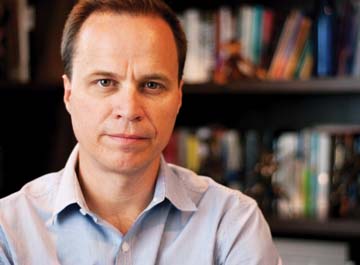By Jorge Casuso
October 13, 2009 -- When he was six years old, Kevin Kelley already knew that when he grew up he wanted to create dramatic spaces.
Kelley, whose branding firm Shook Kelley has been hired to give Downtown Santa Monica's image a makeover, would watch as his mother sewed the dresses she would wear to cocktail parties he imagined were just like the ones Cary Grant or James Bond attended in the movies.
“She would walk out of the room,” Kelley recalls. “I remember the point where I would stand in the kitchen. She would reappear in white boots and her new dress. Wow!”
“In my world, I concocted this dream,” says Kelley, the company's principal-in-charge of brand strategy and conceptual design. “I wanted to create these spaces.”
 |
| Kevin Kelley |
That sense of “Wow,” the romance that can be evoked by a space, would become an all-consuming passion that led Kelley to become an architect and a nationally renowned authority on getting inside the minds of consumers and determining how a space shapes their behavior.
“I was interested in how humans perceive their physical environment. I would start with the senses – smell, touch, hearing – and try to understand how humans perceive, how the brain works.”
A self-proclaimed “anti-architect,” Kelley has always spent much of his time writing and thinking before making a sketch. He would have loved to be a researcher, but it was hard to get funding to test his theories. “The answer was to get retail to pay for it.”
At first, he designed restaurants. He used the knowledge he had culled from the books on psychology, anthropology and sociology. His reading taught him that psychology, religion and business all promised the same thing – salvation.
Restaurants, Kelley concluded, weren’t selling food and service, they were selling “the perception of food and the perception of service.”
Kelley began to apply his theory to everything from grocery stores to theme parks, “from how to sell Oreo cookies, to how to sell a place.” He would try to boil down the client’s message – what they were promising – to a single word or two.
“The client loved it. So did the bankers,” Kelley says.
The next project he would tackle would put the company he launched with fellow architect Terry Shook on the map. The project was transforming a dilapidated one-mile stretch in Charlotte called the corridor, and the first thing Kelley did was change the name.
“Nobody wants to be in a corridor,” says Kelley. “It’s for getting from one place to another.”
The area’s name was changed to the South End Development Corporation, and Kelley would embrace all the negative icons associated with the dead industrial strip.
“We took the smokestack and made it an icon” and planned to bring back the trolley system that hadn’t run in years. City officials called it “The Folly.”
Kelley found an old trolley car – number 85 – a woman had turned into her home, bought it, cleaned it and ran it down the track. At first, it ran 64 feet and some 64,000 people came out to see it the first year. Then it ran 100 feet, and the crowds grew to 100,000 a year.
Kelley asked the City Council for a $19 million loan to revitalize the area and offered to pay the City back $300,000 in economic development money. Today, Kelley says, that number has grown to $1 billion.
“I started lecturing about urban corridors,” says Kelley, who has taught professional courses on branding and marketing at Harvard. “I started going to other communities out of sheer love of place.”
His latest project took him to the Philippines, where he worked to link two very different cities separated by a dead zone. After a year of grueling work in the sweltering tropical heat, he was ready to stay near his Hollywood home and tackle a more modest project that is close to his heart.
Kelley, who is a member of the Urban Land Institute (ULI) and the International Downtown Association (IDA), plans to present a branding strategy to the Bayside District Board that will take his team three months to craft.
“We’re in the discovery phase,” he says. “We’ve made no judgements. We try to look through the eyes of the people who use that space.”